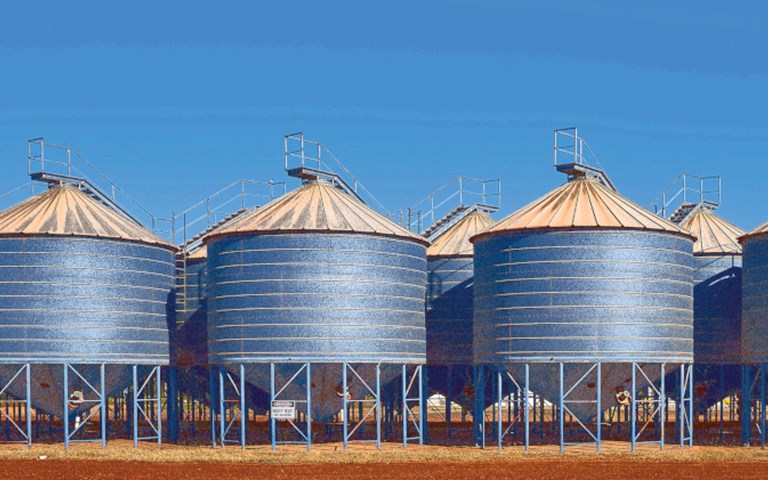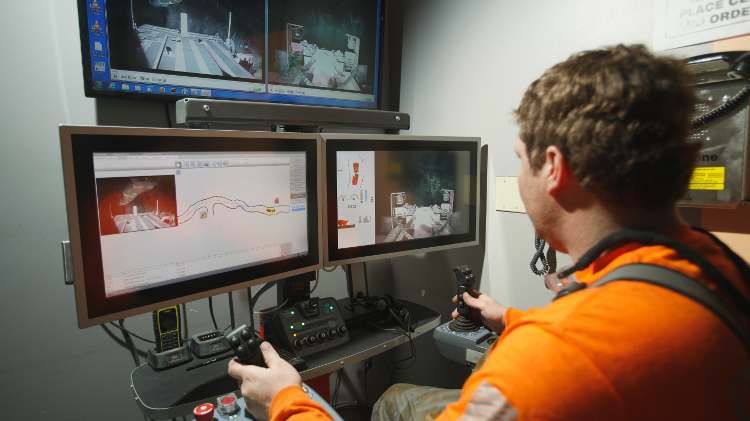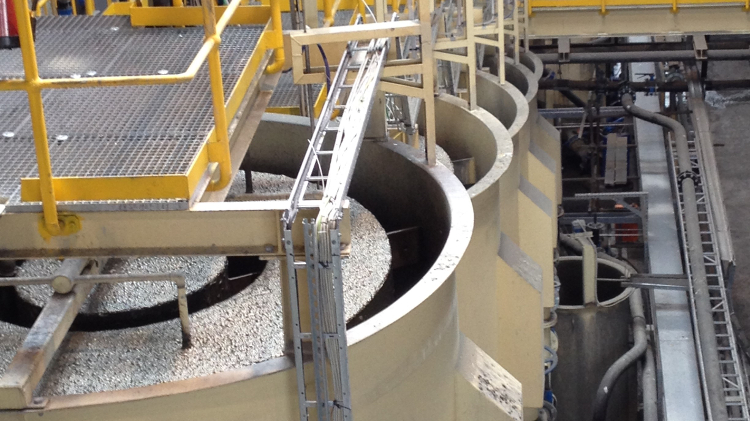How can companies connect disparate data silos?The next step in the march toward the intelligent mine is to facilitate information sharing between systems

With automation initiatives well on their way, some major mining companies have embarked on the next step in the transformation of mining. “The intelligent mine” is a vision for an operation that can leverage new artificial intelligence technologies and machine learning algorithms that sift through all its automation and systems data to find patterns that identify opportunities for optimization, efficiencies, preventive maintenance, problem solving, safer and more environmentally sustainable operations, and more informed and strategic business decisions. It is a mine in which data from one piece of automated equipment or process is seamlessly analyzed against data from other automated systems upstream and downstream. In other words, it is a highly integrated and automated mine from pit to port and sensor to boardroom that is constantly learning from itself, adapting and improving.
The path to the intelligent mine has not yet been paved and companies are only just beginning to figure out what it will look like, but there is some consensus. It will require data integration and breaking down the silos that have arisen from the rollout of a series of discrete technologies, which made each roll out manageable on its own, but does not establish a clear path to higher level integration. And all agree it is a path best travelled one step at a time with good partners.
The disconnect
Automation has largely been introduced into mining operations one area at a time, whether it is haul trucks and drills with proprietary onboard systems at the mine site by various manufacturers or instrumentation and automated equipment at the processing plant. “The industry has a good degree of automation, but it’s in silos,” said Fabio Mielli, market development manager for mining, cement and heavy industry at Rockwell Automation. “They have a lot of pockets of automation in such things as their fleet, material handling processing, rail systems and shipments but you don’t have the connection between the data. Many are still using Excel or other such tools to move information from one side to the other.”
Others still have multiple legacy software applications and databases from the days when these were created as standalones. “It’s a major challenge when you have many different software systems,” said Mielli. “Collecting something from an automation system, even an older one, is still easier than when you have applications from different software from all kinds of vendors, maybe 15 or 20 years old. Then you have a major challenge because you have to simplify the infrastructure in order to collect the data.”
 Last year, Metso partnered with Rockwell Automation to build an industrial Internet of Things (IoT) platform and service that remotely connects, monitors and performs predictive and optimization analytics for its crushers and vibrating screens at the mining operations of its customers. Courtesy of Metso
Last year, Metso partnered with Rockwell Automation to build an industrial Internet of Things (IoT) platform and service that remotely connects, monitors and performs predictive and optimization analytics for its crushers and vibrating screens at the mining operations of its customers. Courtesy of Metso
This is an issue Anglo American has had to tackle in its plans to move toward full integration and intelligence. “We need to make sure that we have enough reliable sensors to be able to capture relevant data and integrate it with other legacy data systems. This part is the most challenging, because many of these systems were built separately, over time, and have different access methods,” said Arun Narayanan, Anglo American’s group head of data analytics. “The integration challenge is at the heart of our data analytics program. It makes sense to look at it iteratively to best determine how we can update and sustain the reliability of these data systems over time.”
Anglo American is prepared to face the challenges to achieve integration because it has already experienced success with its data analytics program. For example, it has used advanced analytics in its marketing division to help change the way it was responding to certain commodity markets, said Narayanan. “Similarly, we’ve had measurable successes in discovery and geosciences, in terms of better understanding our ore bodies and predicting behaviour through our processing plants,” he said. “We will be using this in a live production environment onsite by mid-2019, and have other projects that implement predictive maintenance workflows.”
Now, the company sees, “a role for machine learning to help us in mission-critical areas such as improving safety and sustainability,” said Narayanan. “To achieve the full benefit, we need to look one step beyond individual value chain components to fully integrating the entire value chain – albeit digitally. That is a promise that the future holds for us.”
From information silos to data lakes
To fully realize the intelligent mine, artificial intelligence needs to analyze data not merely within systems but also between and across them. “It’s not just aggregating information, it’s also about making the connection and having information in context at the right time and how it relates from one system to the other,” said Mielli. “Energy is one system and production is another system but they are related, for example. If you want to increase production, you are going to use more energy but that is coming from a different system.”
As well, the data cannot simply be from sensors and automated technology. “For example, say you’re operating a haul truck 365 days a year,” said Carl Brackpool, product manager and innovation lead at Hexagon Mining and a research associate at the Colorado School of Mines. “Predictive analytics would say let’s also take environmental data, how many people operate the truck, when is payday, and the road conditions and it might find that there is an event pattern, say a flat tire the day after payday on a particular part of the road when it’s very windy. Then on such days, you just have to remind your operators to drive more slowly when they hit that particular part of the road.”
For this reason, Anglo American is implementing what is known as a data lake, which is essentially one gigantic pool of every bit of data in the organization, including enterprise resource planning (ERP) data, environmental data, sale force data, process control and automation data. The lake allows the company’s systems to access all available data as it needs it.
Integrated analysis
Only two years ago, hardware and software interoperability – the ability of one system to communicate with another – was a major obstacle as manufacturers fiercely guarded their proprietary systems. Today an increasing number of suppliers to the industry, from original equipment manufacturers (OEM) to ERP providers, are jumping on the interoperability and data analytics bandwagon.
On the ERP side, SAP Industries has created a suite of offerings to help increase interconnectivity in a mine and data analytics. The SAP Digital Transformation Framework is built on a methodology around what the company describes as the “digital core,” which supports real-time transactions and analytics and connects the supply chain, customer experience, supplier collaboration and workforce engagement, said Peter Maier, the company’s co-president.
The SAP S/4HANA platform provides real-time access to resource availability and project assignments, as well as real-time outlook into maintenance planning. SAP’s cloud-based Leonardo technology enables easier collection and visualization of data. “By bringing SAP S/4HANA and SAP Leonardo technologies together as the digital core of a company, this creates a more flexible and intelligent mining enterprise,” said Maier.
On the OEM side, Caterpillar’s MineStar suite of technologies is designed to integrate with business management and ERP systems, long-term, medium-term and short-term planning technologies as well as site operation controls and fleet equipment management. The company has also beaten interoperability issues in autonomous drilling with a bolt-on system it developed for ArcelorMittal’s Mont-Wright mine in Quebec that can be used on all drills, regardless of its manufacturer.
Related: ArcelorMittal opts for a partial autonomous drilling system at its Mont-Wright mine
Hexagon Mining, which provides information and automation technologies that connect people and processes across surveying, design, fleet management, production optimization and collision avoidance, has an “orchestration of layers that talk to all types of software that we own and we’ve even opened a number of those to our competitors’ data,” said Brackpool.
The company is committed to the vision of collaboration and breaking down silos across providers and even industries to help build the intelligent mine of the future. “We don’t want to be the ones that are defensive and be highly proprietary where only our data can work with our systems,” said Brackpool. “We offer an application program interface (API) for someone else’s planning software to be injected into our underground software suite.”
An API is a web-based set of requirements and rules that, if followed, open access to other systems or programs. APIs are what allow different applications and platforms to talk to each other. “I’m a real believer that APIs are a great fast-track solution for mining,” said Penny Stewart, Petra Data Science’s managing director. “There is a lot of great software out there that is working in silos but this is where APIs could enable them to integrate more efficiently.”
Integrating control systems
As an organization specialized in industrial automation and data technology, Rockwell provides a combination of sensor and software products that can build a bridge between software systems, including ERP and control systems. “We are unique in this combination of control systems integration solutions as a strategy,” said Mielli.
The company’s FactoryTalk Analytics platform gathers data from control systems, digesting the data in different formats and delivering it in a dashboard. “It’s a collection of different applications,” he said. “So you have data coming from the control systems, supervision and a historian, and this layer gets the data from all the subsystems, digests the data and delivers information in context.”
 Metso can collect vast amounts of data from a large amount of sensors within equipment enabled with its IoT platform at 1-second resolution or higher. Courtesy of Metso
Metso can collect vast amounts of data from a large amount of sensors within equipment enabled with its IoT platform at 1-second resolution or higher. Courtesy of Metso
Last year, Metso partnered with Rockwell Automation to build an industrial Internet of Things (IoT) platform and service that remotely connects, monitors and performs predictive and optimization analytics for its crushers and vibrating screens at the mining operations of its customers. The goal is to increase uptime and reduce the need for servicing and maintenance crews onsite. Metso launched the platform in November. “There’s been a big push for autonomy on the mine site,” said Jani Puroranta, chief digital officer of Metso. “Now we are trying to do the same in the mineral processing plant. On the fixed plant side, autonomous can mean the machines can adjust to minor variations in the process as needed but also they break down much less. So there is less need for people on the ground. More is planned and prevented so you can plan things ahead of time.”
The new platform uses Rockwell’s FactoryTalk Analytics. “The platform can handle data in many formats and normalize the data,” said Puroranta. “So Rockwell does that and turns it into integrated data.”
The connector
Petra Data Science is an artificial intelligence company focused on the resource sector that has produced hundreds of machine learning algorithms to help mining companies integrate data and use it to optimize their processes. The most recent addition to Petra’s offering is MAXTA, the world’s first digital twin for mine value chain optimization. MAXTA integrates data from the geology of an ore body, tracks the ore, builds virtual stockpiles, and incorporates the drill and blast data into the model. The model is then analyzed on how it will perform, allowing it to predict everything from throughput to grade, recovery and even the grade of the tailings. The MAXTA algorithm was used recently to optimize processing at PanAust’s Ban Houayxai gold and silver operation in northern Laos by integrating two years’ worth of 3D geological data with plant data to create both backward reconciliation analysis and forward predictions.
“The effort for integration has come down from what it was a few years ago,” said Stewart. “Yes, data integration from different systems can be solved. We have worked out how to integrate their data formats into our products, whether it is for MAXTA digital twin, or our machine learning process. There is an amount of work needed to integrate that data, but in my view it’s not a huge issue.”
Stewart said she believes that full integration will be built organically, step by step, by integrating existing systems through collaboration and APIs. As a provider of the types of artificial intelligence solutions that are at the root of mining companies’ aspirations for the intelligent mine, Stewart does not believe that integrating data today is much of a roadblock.
“Some people have an idea that we need a universal platform that will go across the whole operation and play everywhere and be generic, but I think by the time you build that, it’s going to be out of date,” she said.
Stewart provided two examples of how integration can grow organically. One is Petra’s collaboration with Resolutions Systems, whose flagship product, MaxMine, is a business improvement platform that receives data from load and haul equipment and identifies opportunities to optimize. “Through our collaboration, we’re enabling them to provide us with data from the mine and automatically link that to the processing plant,” she said. “That’s taking a mine production software and integrating it into the processing plant from the mine to the mill.”
Petra is also collaborating with mine planning software companies such as Maptek. “These collaborations will enable the assumptions mine planning is built on, whether it’s shovel productivity assumptions or how the ore is going to behave in the plant, to be estimated based on hundreds of millions of tonnes of historical data,” she said. “So we are integrating data from the plant back to the mine planning process to get more accurate estimates and adding a layer of machine learning.”
One step at a time
The journey toward the fully integrated intelligent mine has barely begun. Brackpool said he believes most mining companies should begin the journey by focusing on solving a problem. “Don’t buy a technology because it’s cool and create a problem to solve,” he said. “First of all, understand your problem and then apply the technology.”
For many companies, the first problem may just be the need to lay down a basic foundation. For those with numerous legacy systems still working with paper and Excel spreadsheets, early steps could be streamlining their systems and increasing automation.
“If you have a legacy IT structure with a lot of software applications and need to modernize the infrastructure, you don’t want to change everything at once,” said Mielli. “You have to do it step by step because you can’t stop production. You have to migrate the systems and modernize the infrastructure. You have to partner with someone. I believe in the power of partnership.”
Meanwhile, companies such as Anglo American that are ahead of the game are laying down the next-level foundation upon which the intelligent fully integrated mine will possibly be built. “The process of mining is complex, requiring many different pieces of equipment, technologies and sciences,” said Narayanan. “With so many different complicated efforts, the chance for big data to make a big impact is great.”
More Technology

The automation revolution
There is no doubt the future of mining is automation. But what does that look like, and how will we get there?

The future of flotation
Buoyed by pressure to cut costs and improve recovery, new flotation technologies are on the rise

